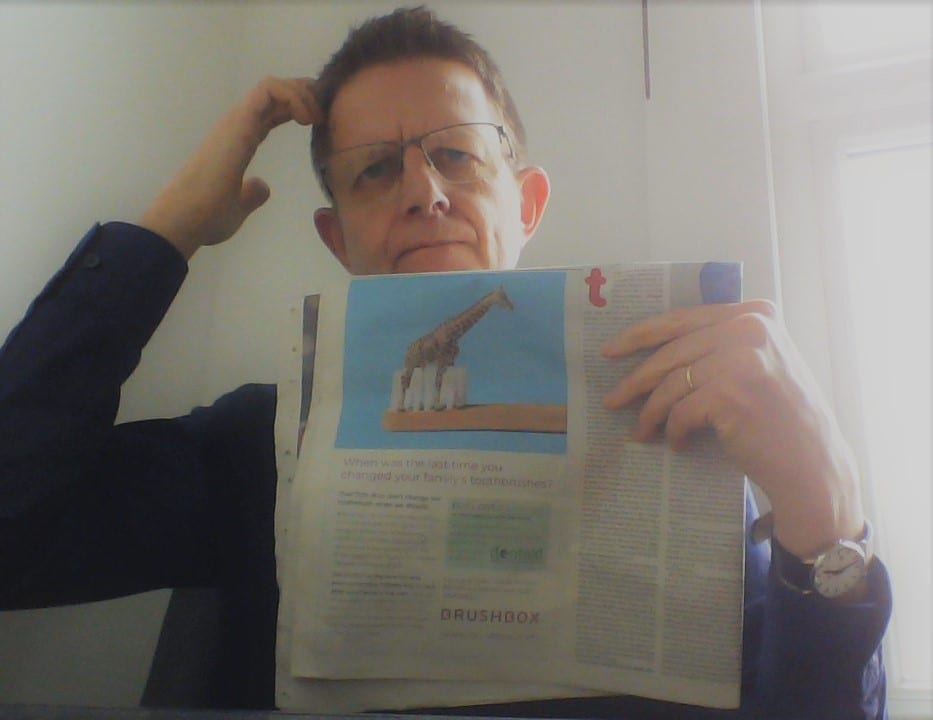
Giraffes, razors and jet engines: the re-emergence of the subscriber
There are attractions in the subscription model, but only if it’s genuinely customer-centric
Somewhere along the road from a government department to an FTSE100-floated plc, BT stopped referring to its subscribers and started referring to them as customers. Strangely, the outmoded term is making a comeback as more and more companies try to move their customers onto a subscription model for their products and services.
The problem is, it’s not going to work for everyone.
I got confused by an advert in London’s Evening Standard this week: it features a toy giraffe in a toothbrush and on closer inspection is promoting a new subscription service – Brushbox – for toothbrushes and toothpaste.
That’s right, those commonplace items you can find in any supermarket, corner shop or chemist. I’m struggling to see why anyone would need to sign up for a service that sends you a new toothbrush when you should be changing it. Presumably you’re one of the feckless “70% of us who don’t change our toothbrush when we should”. The advert, which promises “a fun and environmentally friendly way to look after your family’s oral care” reminds us that 1 in 3 children are starting school with signs of tooth decay so it’s basically tooth-shaming you into coughing up for a subscription.
Razor boy
I’m not immune to the charms of a subscription service though: I’ve been having razor blades delivered to my home on a regular basis and that works for me as the product – Harry’s in my case (other subscription services are available) – is superior to others that I’ve used and isn’t available in shops. I don’t think I’m paying a premium for this either – possibly because replacement blades are eye-wateringly expensive whether you buy them in a shop or online.
The model has been well-established in the business sector for many years. When I started out in the computer industry a few decades ago, we would seek maintenance contracts as a way of extending our software project income and also giving the client the ability to have regular upgrades. The other night I was talking to someone about how Rolls-Royce’s jet engine sales include an ongoing maintenance contract – sensor technology enables Rolls Royce to keep tabs on engine condition and notify the aircraft operator of any problems in real time. Preventing a flight taking off with a faulty engine seems like a premium worth paying and in the long term will more than likely have cost benefits for the subscriber in reduced overall down time.
But I’m wondering if in the consumer world we may well have reached “peak subscriber”…
Too many schemes, not enough customers
The subscription model clearly has benefits for customers but, on inspection, has even more attraction for businesses and their investors. Viewing customers as a source of ongoing income is easier to account for than a number of one-off transactions. And advances in technology mean that businesses can use the data gleaned from the customer base to predict demand and tailor offerings accordingly.
However, as an article in The Economist (another of my subscriptions) points out, the downside of the model lies in the high cost to subsidise customer acquisition and likely increasing volatility of the market. As competitors offer better subscription schemes, customers will vote with their feet and, with more businesses finding ways to run subscription schemes the choice will only increase.
Lock-in
The answer to this, at first sight, is to make it difficult for customers to end their subscriptions early. Some gym chains, for example, have been doing this for years, locking customers into annual schemes at a reduced rate. This approach is anything but customer-centric: it’s a defensive manoeuvre that gets the business off the hook of continuing to make their offer more attractive.
And this is the nub of the challenge: those businesses that will succeed with a subscription model are those that commit to continuously improving the value they deliver to customers. Netflix, for example, continues to offer high-quality unique content to its subscriber base and has a low customer churn rate as a result. Spotify, the music streaming service, has a more volatile base as much of its content is available from other sources – YouTube and recorded media – and faces a challenge of proving to enough paying customers that it provides something unique.
Businesses adopting a subscription model need to get their priorities straight: provide a compelling reason to subscribe (hint: customer outcomes are a good way to start) and then work out how that subscriber base gets “monetised”.
I’m still confused by the giraffe though.





